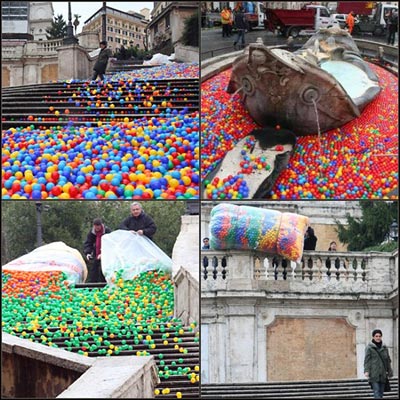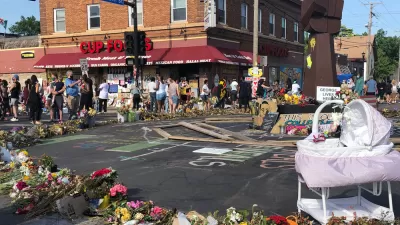The other day, half a million plastic balls bounced down the Spanish Steps, one of Rome's most visited and historic public places. Many visitors, picture-takers and members of the media were caused to wonder 'what's up with all these balls?'
The other day, half a million plastic balls bounced down the Spanish Steps, one of Rome's most visited and historic public places. Many visitors, picture-takers and members of the media were caused to wonder 'what's up with all these balls?'

(photo by Flickr user mareadjrock)
What's up, in my perspective, is a reminder that the public places of the world truly do belong to us all -- and are subject to whatever beautiful, horrible and cracked-out things we want to use them for.
The guy who dropped the balls says he was trying to represent the Italian government's "corrupt" system, with each ball representing a lie told by politicians. Graziano Cecchini, the same guy who dyed the waters of Rome's Trevi Fountain blood red in October, was promptly detained by police after emptying bags full of thousands of small plastic balls at the top of the historic staircase.
The video linked above shows the flow of balls down the staircase as confused and amused onlookers look on. It's a real-life, though less compelling, version of a commercial from a couple years back in which a bunch of bouncy balls were dropped down a hill in San Francsico by a private company to sell TVs.
You could call what Cecchini did vandalism, activism, littering, public art, or any number of adjectives. But the definition doesn't really matter as much as the (probably unintentional) statement it makes about the utility and inherent democracy of public spaces. These are places built for use and reinterpretation by the public. Especially in older cities, the public for whom these public spaces were originally built have been dead for hundreds of years, meaning the places are subject to be used and abused as the subsequent publics decide. This can take the form of riots, farmers markets, parades, and, yes, a staircase covered with balls.
This act is a reminder that we need to keep public ownership of our historic public places, and sustain that mentality as our cities build new places intended for the public. A recent article from the Los Angeles Times Magazine looking at the new public spaces being built in the city determined that nearly all of them were "shaped, controlled or compromised by private, commercial or other interests." Many things in our modern lives are owned or sponsored or presented by some major corpooration, and I assume the public spaces in other cities beyond L.A. are experiencing the same "privatization" discussed in the article.
Cecchini's balls (which, you have to admit, must be huge) are an exercise in civil disobedience and a call to urban dwellers everywhere to keep public spaces truly public. That means accessible, usable, unpredictable, and, like some famous guy once said, of the people, by the people, and for the people.

Alabama: Trump Terminates Settlements for Black Communities Harmed By Raw Sewage
Trump deemed the landmark civil rights agreement “illegal DEI and environmental justice policy.”

Planetizen Federal Action Tracker
A weekly monitor of how Trump’s orders and actions are impacting planners and planning in America.

The 120 Year Old Tiny Home Villages That Sheltered San Francisco’s Earthquake Refugees
More than a century ago, San Francisco mobilized to house thousands of residents displaced by the 1906 earthquake. Could their strategy offer a model for the present?

Ken Jennings Launches Transit Web Series
The Jeopardy champ wants you to ride public transit.

BLM To Rescind Public Lands Rule
The change will downgrade conservation, once again putting federal land at risk for mining and other extractive uses.

Indy Neighborhood Group Builds Temporary Multi-Use Path
Community members, aided in part by funding from the city, repurposed a vehicle lane to create a protected bike and pedestrian path for the summer season.
Urban Design for Planners 1: Software Tools
This six-course series explores essential urban design concepts using open source software and equips planners with the tools they need to participate fully in the urban design process.
Planning for Universal Design
Learn the tools for implementing Universal Design in planning regulations.
Clanton & Associates, Inc.
Jessamine County Fiscal Court
Institute for Housing and Urban Development Studies (IHS)
City of Grandview
Harvard GSD Executive Education
Toledo-Lucas County Plan Commissions
Salt Lake City
NYU Wagner Graduate School of Public Service




























